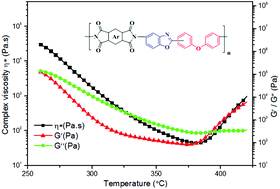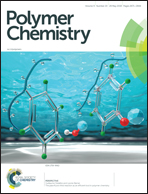Processable poly(benzoxazole imide)s derived from asymmetric benzoxazole diamines containing 4-phenoxy aniline: synthesis, properties and the isomeric effect†
Abstract
Two asymmetric diamine monomers, incorporating both aryl ether and non-linear benzoxazole groups, namely 5-amino-2-(4-(4-aminophenoxy)phenyl)benzoxazole (p-BOODA) and 5-amino-2-(3-(4-aminophenoxy)phenyl)benzoxazole (m-BOODA), were designed and synthesized. Two novel series of poly(benzoxazole imide)s (PBOIs), PI-3(a–e) and PI-4(a–e), were prepared via thermal imidization of commercial tetracarboxylic dianhydrides with diamines p-BOODA and m-BOODA, respectively. The effects of chain isomerism on molecular packing and the physical properties of PBOIs are investigated. These PBOIs showed excellent mechanical properties with tensile strengths of 106–168 MPa, tensile moduli of 2.7–5.5 GPa and elongations at break of 4.4–9.3%; in addition, they exhibited good thermal stability (T5% = 488–570 °C) and high glass transition temperatures (Tgs) up to 333 °C. Moreover, BTDA (3,3′,4,4′-benzophenone tetracarboxylic dianhydride) derived PBOIs, PI-3b and PI-4b, showed crystalline transition in spite of bent groups and the asymmetric chain structure. The incorporation of the asymmetric benzoxazole structure with flexible ether connecting groups improved the solubility of the PBOI system. Furthermore, the controlled molecular weight (Mw) polymer PI-4e-PA derived from m-BOODA demonstrated excellent solution and melt processability with the lowest complex viscosity of 44 Pa s at 380 °C.



 Please wait while we load your content...
Please wait while we load your content...